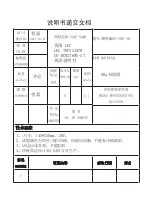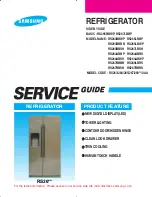
Because a refrigerator is a combination of several components, they are similar.
In case a problem occurs, do not make a hasty conclusion based on only one problem. It
is advisable to analyze or conduct troubleshooting comprehensively because several
problems may share a common problem and several problems may occur simultaneously
due to a certain fault.
6.3 Analysis Of Problem And Troubleshooting
A. Poor Refrigerating Effect
The so-called “Poor refrigerating effect “refer to the situation where the refrigerator
operates normally, but does not cool to the temperature indicated by the thermostat.
Possible causes are discussed and analyzed below:
1.Leakage of refrigerant
Analysis
The refrigerant leakage will result in an insufficient refrigerating capacity. This will lead
to lower gas suction and exhaust pressure as well as hotter exhaust gas. The exhaust tube
will become extremely hot, and the sound of gas flowing from outlet of the capillary will
become louder than usual. After shut down, the balance pressure in the system is lower
than the saturation pressure corresponding to the same ambient temperature.
Remedy
Locate the refrigerant leak points immediately and note leaking points and parts. Repair
them and recharge refrigerant. In troubleshooting, pay particular attention to possible
leaking points; check main connection points for oil seepage and tubing for cracks, if
leakages are not severe, charge system with nitrogen and detect with best commonly
adopted method. Repair, evacuate, charge system with refrigerant and turn on refrigerator
to make test run. Drain the system of the nitrogen before refill with refrigerant.
2.
Too much refrigerant charged in the system
Analysis
a.
If amount of refrigerant in the system exceeds its nominal capacity, the excess
refrigerant will displace the evaporator. This will reduce the heat-dissipation area and
decrease the refrigerating efficiency. Malfunctions caused by excess refrigerant are: gas
suction and exhaust pressures increase, condenser becomes hotter, the electric current of
the compressor rises, frost forms on the evaporator and gas return tube, and the
refrigerator temperature drops slowly.
b
. In case of excessively charged refrigerant, the liquid refrigerant that cannot evaporate
in the evaporator will return to the compressor. This will cause “liquid striking.” The
liquid refrigerant evaporates and effervesces as soon as it flows into the refrigerating oil
at the bottom of compressor. If the condition is severe, foams will cover the inside the
compressor housing and be sucked by the piston, causing damage to the components of
compressor.
Summary of Contents for RF-8888-174
Page 7: ......








































